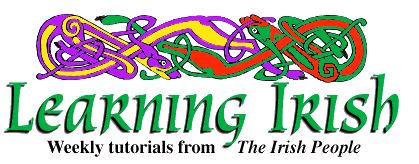
Irish Lesson 9
|
PRONUNCIATION We will now look more closely at some vowel sounds before taking up any more consonants. First comes "o". We represent its sound by (oh) for simplicity, but the actual Irish sound is noticeably different from English "oh". To see this, stand before a mirror and watch your lips as you pronounce the word "oh" slowly. You will see them contract and move out to make an (oo) sound at the end. English "oh" is really a diphthong, a close combination of two vowels. The Irish sound is a single vowel, made with lips held rounded. Watch you lips again as you say English "oak" slowly. Then try to say it without contracting your lips. You will have the distinctive sound that has sometimes come into English. Try: óg, ól, ón, ór, ós. This vowel sound should be held longer than in English. If there is no síneadh fada (SHEEN-uh FAH-duh) over an "o" which is nevertheless stressed in a word, pronounce it in the same way but do not hold it as long. Try: obair (OH-bir), oscail (OH-skil), ocht (ohk*t). Notice that this shorter sound may resemble (uh), but in Irish you should not make the error of saying (uh) for this shorter "o". Keep your lips more rounded and contracted than for (uh). Next, try "ocht" and then "ucht" (uk*t), and notice the difference.
REFLEX EXPRESSIONS Ná bac leis (naw* bahk lesh), never mind, don't worry about it. Buíochas le Dia (BWEE-uhk*-uhs le DEE-uh), Thanks be to God, thank Heaven. Tá go maith (taw* goh mah), All right. Is cuma liom (is KUM-uh luhm), I don't care, it's all the same to me. An ndéir tú liom é? (un NAY*R too luhm ay*), You don't say (literally: Do you say it to me? Fan go fóill (fahn goh FOH-il), Wait a minute, take it easy.
CHECK LIST
If you answered "No" to any of these questions, you can benefit from reading Lessons 1 to 3 over again.
GRAMMAR AND VOCABULARY Here are some imperatives to learn. Note that if you want to tell a person not to do something, you put "Ná" (naw*) before the imperative. Déan é (day*n ay*), Do it. Ná déan é (naw* day*n ay*), Don't do it. Léigh é (lay* ay*), Read it. Ná léigh é (naw* lay* ay*), Don't read it. Scríobh é (shkreev ay*), Write it. Ná scríobh é (naw* shkreev ay*), Don't write it. Cuir ar an mbord é (kir er un mohrd ay*), Put it on the table. Ná cuir an bosca ar an mbord (naw* kir un BOHSK-uh er un mohrd), Don't put the box on the table. Éist liom (ay*sht luhm), Listen to me. Ná héist leis (naw* hay*sht lesh), Don't listen to him Ól an bainne (ohl un BAHN-ye), Drink the milk. Ná hól an tae (naw€ hohl un tay€), Don't drink the tea. When "Ná" precedes a verb that starts with a vowel, an "h" is put before the verb, as in two examples above. Note also that "é" (ay*), which means "him" or "it", and "í" (ee), which means "her" or "it", are usually put at the end of the sentence.
CONVERSATION Seoirse (SHOHR-she): Chuala mé é, go cinnte (K*OO-uh-luh may* ay*, goh KIN-te). I heard it, certainly. Bhí sé ag screadadh an oíche go léir (vee shay* uh SHKRAD-uh un EE-huh goh lay*r). It was screeching the whole night. Agus bhí cat eile ann, freisin (AH-guhs vee kaht EL-e oun, FRESH-in). And there was another cat there, too. Maire: Cara leis, is dócha (KAH-ruh lesh, is DOHK*-uh) A friend of his I, suppose. Seoirse: Codladh sámh agat anocht (KUHL-uh saw*v uh-GUHT uh-NOHK*T). Sound sleep to you tonight. Notes: In pronouncing "Máire", you must put a faint (i) sound between the (maw*) and the (re) sounds. This makes the word sound somewhat like "Moyra" or "Moira", English attempts to represent the sound. (c) 1997 The Irish People. May be reprinted with credit. |